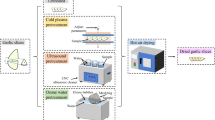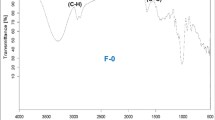Abstract
Glass transition temperature (T g) of spaghetti sample was measured by thermal and rheological methods as a function of water content from 0 to 70 kg/100 kg spaghetti. In the cases of sample containing un-freezable water (i.e., amount of water which did not form ice even at very low temperature), calorimetric measurements performed by differential scanning calorimetry showed that the T g values decreased from 142.8 to 42.7 °C when water content increased from 0 to 13.95 kg/100 kg spaghetti, respectively. Glass transition temperature increased with the increase of heating rate (2–50 °C/min) and reached to a nearly constant value above 30 °C/min. Thermal mechanical compression test showed relatively lower T g values compared to the DSC values at low moisture contents, whereas at high moisture content T g showed higher values. In the cases of samples containing freezable water (27–70 kg/100 kg spaghetti), glass transition shifts were merged with the ice melting endotherm. The freezing point, measured from the endothermic peak, decreased with the decrease of water content. In the state diagram, maximal freeze-concentration condition was determined as \( X_{\text{s}}^\prime \)=0.81 kg/kg spaghetti from the intersection of the extended freezing curve and a horizontal line passing thru \( T_{\text{m}}^\prime \) = −10.3 °C.







Similar content being viewed by others
References
Alvarez, M. D., Fernandez, C., & Canet, W. (2009). Oscillatory rheological properties of fresh and frozen/thawed mashed potatoes as modified by different cryoprotectants. Food and Bioprocess Technology, doi:10.1007/s11947-007-0051-9, in press.
Bai, Y., Rahman, M. S., Perera, C. O., Smith, B., & Melton, L. D. (2001). State diagram of apple slices: glass transition and freezing curves. Food Research International, 34(2–3), 89–95.
Bell, L. N., & Touma, D. E. (1996). Glass transition temperatures determined using a temperature-cycling differential scanning calorimeter. Journal of Food Science, 61(4), 807–828.
Bhandari, B. (2007). Novel and simple technique for measuring the glass transition and melting temperature of solid food and non-food materials. SIST Annual 2007. Singapore Institute of Food Science and Technology.
Biliaderis, C. G., Page, C. M., Maurice, T. J., & Juliano, B. O. (1986). Thermal characterization of rice starches: a polymer approach to phase transitions of granular starch. Journal of Agricultural and Food Chemistry, 34, 6–14.
Boonyai, P., Howes, T., & Bhandari, B. (2007). Instrumentation and testing of a thermal mechanical compression test for glass–rubber transition analysis of food powders. Journal of Food Engineering, 78, 1333–1342.
Chittur, K. K. (1998). FTIR/ATR for protein adsorption to biomaterial surfaces. Biomaterials, 19, 357–369.
Cocero, A. M., & Kokini, J. L. (1991). The study of the glass transition of glutenin using small amplitude oscillatory rheological measurements and differential scanning calorimetry. Journal of Rheology, 35(2), 257–270.
Cremer, D. R., & Kaletunc, G. (2003). Fourier transform microspectroscopic study of the chemical microstructure of corn and oat flour-based extrudates. Carbohydrate Polymers, 52, 53–65.
Cuq, B., Goncalves, F., & Mas, J. F. (2003). Effects of moisture content and temperature of spaghetti on their mechanical properties. Journal of Food Engineering, 59(1), 51–60.
Fabian, H., & Schultz, C. P. (2000). Fourier transform infrared spectroscopy in peptide and protein analysis. In R. A. Meyers (Ed.), Encyclopedia of Analytical Chemistry (pp. 5779–5803). Chichester: Wiley.
Giannou, V., & Tzia, C. (2008). Cryoprotective role of exogenous trehalose in frozen dough products. Food and Bioprocess Technology, 1, 276–284.
Jaya, S., & Das, H. (2009). Glass transition and sticky point temperatures and stability/mobility diagram of fruit powders. Food and Bioprocess Technology, 2, 89–95.
Kasapis, S., Al-Mathoobi, I. M., & Mitchell, J. R. (2003). Testing the validity of comparisons between the rheological and calorimetric glass transition temperatures. Carbohydrate Research, 338, 787–794.
Kazemzadeh, M., Aguilera, J. M., & Rhee, K. C. (1982). Use of microscopy in the study of vegetable protein texturization. Food Technology, 36(4), 111–118.
Levine, H., & Slade, L. (1986). A polymer physico-chemical approach to the study of commercial starch hydrolysis products (SHPs). Carbohydrate Polymer, 6, 213–244.
Martins, R. C., Lopes, V. V., Vicente, A. A., & Teixeira, J. A. (2008). Computational shelf-life dating: Complex systems approaches to food quality and safety. Food and Bioprocess Technology, 1, 207–222.
Maurice, T. J., Asher, Y. J., & Thompson, S. (1991). In H. Levine, L. Slade (Eds.) Water relationships in food. New York: Plenum, pp. 215–233.
Rahman, M. S. (1995). Food properties handbook. Boca Raton: CRC.
Rahman, M. S. (2004). State diagram of date flesh using differential scanning calorimetry (DSC). International Journal of Food Properties, 7(3), 407–428.
Rahman, M. S. (2006). State diagram of foods: its potential use in food processing and product stability. Trends in Food Science and Technology, 17, 129–141.
Rahman, M. S. (2009). Food stability beyond water activity and glass transition: macro–micro region concept in the state diagram. International Journal of Food Properties, 12(4), 726–740.
Rahman, M. S. (2010). Food stability determination by macro–micro region concept in the state diagram and by defining a critical temperature. Journal of Food Engineering (in press).
Rahman, M. S., & Sablani, S. S. (2009). Water activity measurement methods of foods. In M. S. Rahman (Ed.), Food Properties Handbook (2nd ed., pp. 9–32). Boca Raton: CRC.
Rahman, M. S., Al-Marhubi, I. M., & Al-Mahrouqi, A. (2007). Measurement of glass transition temperature by mechanical (DMTA), thermal (DSC and MDSC), water diffusion and density methods: a comparison study. Chemical Physics Letters, 440, 372–377.
Roos, Y. H. (1995). Phase transitions in foods (p. 360). San Diego: Academic.
Sablani, S. S., Shrestha, A. K., & Bhandari, B. R. (2008). A new method of producing date powder granules: physicochemical characteristics of powder. Journal of Food Engineering, 87, 416–421.
SAS. (2001). The SAS System for Windows, Version 8.02, SAS Institute: Cary, NC.
Slade, L., & Levine, H. (1988). Non-equilibrium behavior of small carbohydrate-water systems. Pure Applied Chemistry, 60, 1841–1864.
Slade, L., & Levine, L. (1991). A food polymer science approach to structure property relationships in aqueous food systems: non-equilibrium behavior of carbohydrate–water systems. In H. Levine & L. Slade (Eds.), Water relationships in food (pp. 29–101). New York: Plenum.
Takhar, P. S., Kulkarni, M. V., & Huber, K. (2006). Dynamic viscoelastic properties of pasta as a function of temperature and water content. Journal of Texture Studies, 37(6), 696–710.
Tironi, V., Lamballeric-Anton, M., & Le-Bail, A. (2009). DSC determination of glass transition temperature on sea bass (Dicentrarchus labrax) muscle: effect of high-pressure processing. Food and Bioprocess Technology, doi:10.1007/s11947-007-0041-y, in press.
Tuyen, T.T., Fukai, S., Truong, V., & Bhandari, B. (2008). Measurement of glass–rubber transition temperature of rice by thermal mechanical compression test (TMCT). International Journal of Food Properties (in press).
van Dijk, A., De Boef, E., Bekkers, A., Van Wijk, L., Swieten, E., Hamer, R., et al. (1997). Structure characterization of central repetitive domain of high molecular weight gluten proteins. II. Characterization in solution and in the dry state. Protein Science, 6, 649–656.
Wetzel, D. L. (1993). Molecular mapping of grain with a dedicated integrated Fourier transformed infrared microspectrometer. In: G. Charalambous (Ed.) Food flavors, ingredients and composition. Amsterdam: Elsevier, p. 679
Acknowledgments
The authors would like to acknowledge the support of Sultan Qaboos University and the University of Queensland towards this research in the area of food structure. Special thanks to Dr. Moshtaque Ahmed for checking the clarity of the paper.
Author information
Authors and Affiliations
Corresponding author
Rights and permissions
About this article
Cite this article
Rahman, M.S., Senadeera, W., Al-Alawi, A. et al. Thermal Transition Properties of Spaghetti Measured by Differential Scanning Calorimetry (DSC) and Thermal Mechanical Compression Test (TMCT). Food Bioprocess Technol 4, 1422–1431 (2011). https://doi.org/10.1007/s11947-009-0258-z
Received:
Accepted:
Published:
Issue Date:
DOI: https://doi.org/10.1007/s11947-009-0258-z




